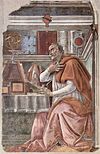Introduction The Catholic Church, also known as the Roman Catholic Church, is the largest Christian church, with 1.39 billion baptized Catholics worldwide as of 2022. It is among the world's oldest and largest international institutions, and has played a prominent role in the history and development of Western civilization. The church consists of 24 sui iuris churches, including the Latin Church and 23 Eastern Catholic Churches, which comprise almost 3,500 dioceses and eparchies located around the world. The pope, who is the bishop of Rome, is the chief pastor of the church. The Diocese of Rome, known as the Holy See, is the central governing authority of the church. The administrative body of the Holy See, the Roman Curia, has its principal offices in Vatican City, a small independent city-state and enclave within the Italian capital city of Rome, of which the pope is head of state. The core beliefs of Catholicism are found in the Nicene Creed. The Catholic Church teaches that it is the one, holy, catholic and apostolic church founded by Jesus Christ in his Great Commission, that its bishops are the successors of Christ's apostles, and that the pope is the successor to Saint Peter, upon whom primacy was conferred by Jesus Christ. It maintains that it practises the original Christian faith taught by the apostles, preserving the faith infallibly through scripture and sacred tradition as authentically interpreted through the magisterium of the church. The Roman Rite and others of the Latin Church, the Eastern Catholic liturgies, and institutes such as mendicant orders, enclosed monastic orders and third orders reflect a variety of theological and spiritual emphases in the church. Of its seven sacraments, the Eucharist is the principal one, celebrated liturgically in the Mass. The church teaches that through consecration by a priest, the sacrificial bread and wine become the body and blood of Christ. The Virgin Mary is venerated as the Perpetual Virgin, Mother of God, and Queen of Heaven; she is honoured in dogmas and devotions. Catholic social teaching emphasizes voluntary support for the sick, the poor, and the afflicted through the corporal and spiritual works of mercy. The Catholic Church operates tens of thousands of Catholic schools, universities and colleges, hospitals, and orphanages around the world, and is the largest non-government provider of education and health care in the world. Among its other social services are numerous charitable and humanitarian organizations. (Full article...) Selected article
 A cardinal-nephew (Latin: cardinalis nepos; Spanish: valido de su tío; French: prince de fortune) is a cardinal elevated by a pope who is that cardinal's uncle, or more generally, his relative. The practice of creating cardinal-nephews originated in the Middle Ages, and reached its apex during the 16th and 17th centuries Pope Boniface IX, the second pope of the Western Schism, did not appoint cardinal-nephews. Until Pope Innocent XII, the only other exceptions were: Pope Innocent XI (who attempted to abolish the practice), popes who did not appoint cardinals (Pope Pius III, Pope Marcellus II, Pope Urban VII, Pope Leo XI), and Pope Adrian VI (who appointed one cardinal).The institution of the cardinal-nephew evolved over seven centuries, tracking developments in the history of the Papacy and the styles of individual popes. From 1566 until 1692, a cardinal-nephew held the curial office of the Superintendent of the Ecclesiastical State, known as the Cardinal Nephew, and thus the terms are sometimes used interchangeably. The curial office of the Cardinal Nephew as well as the institution of the cardinal-nephew declined as the power of the Cardinal Secretary of State increased and the temporal power of popes decreased in the 17th and 18th centuries.
Selected image
 Credit: Leonardo da Vinci Leonardo da Vinci's cartoon The Virgin and Child with St Anne and St John the Baptist combines two themes popular in Florentine painting of the 15th century: the Virgin and Child with St John the Baptist and the Virgin and Child with St Anne. Selected biography
 Jesus of Nazareth (7–2 BC to 26–36 AD), also known as Jesus Christ, is the central figure of Christianity, revered by most Christians as the incarnation of God, and is also an important figure in several other religions. The name "Jesus" is an Anglicization of the Greek Ίησους (Iēsous), itself a Hellenization of the Hebrew יהושע (Yehoshua) or Hebrew-Aramaic ישוע (Yeshua), meaning "YHWH rescues". "Christ" is a title derived from the Greek Χριστός (Christós), meaning the "Anointed One," which corresponds to the Hebrew-derived "Messiah". The main sources of information regarding Jesus' life and teachings are the gospels. Most scholars in the fields of history and biblical studies agree that Jesus was a Galilean Jew, was regarded as a teacher and healer, was baptized by John the Baptist, and was crucified in Jerusalem on orders of Roman Governor Pontius Pilate, on the charge of sedition against the Roman Empire.
Did you know...
Related portalsFeast Day of June 17
Selected quote

News
SubcategoriesTopics
The Holy Bible:
Particular Churches (grouped by liturgical rite):
Things you can do
External resourcesWikiProjectsAssociated WikimediaThe following Wikimedia Foundation sister projects provide more on this subject:
Discover Wikipedia using portals |
How Can We Help?




































Recent Comments